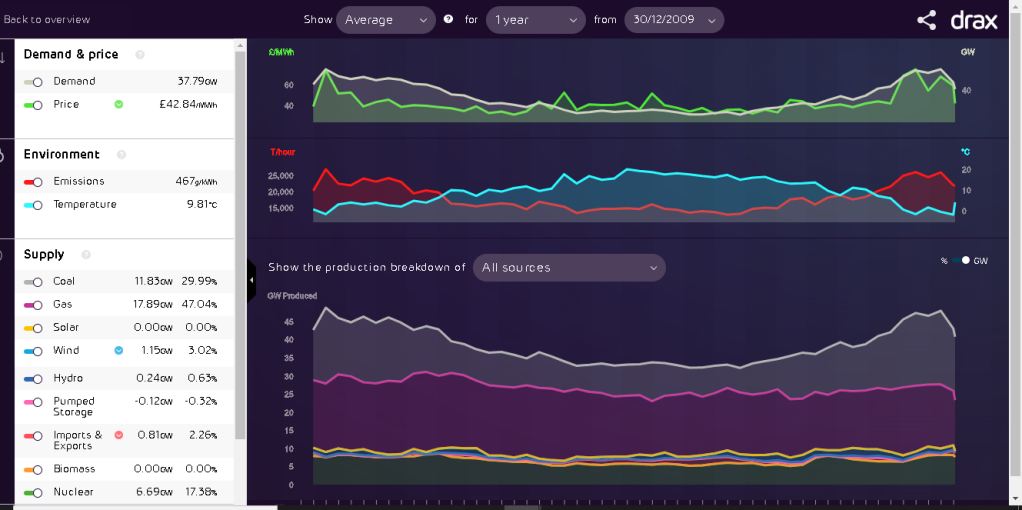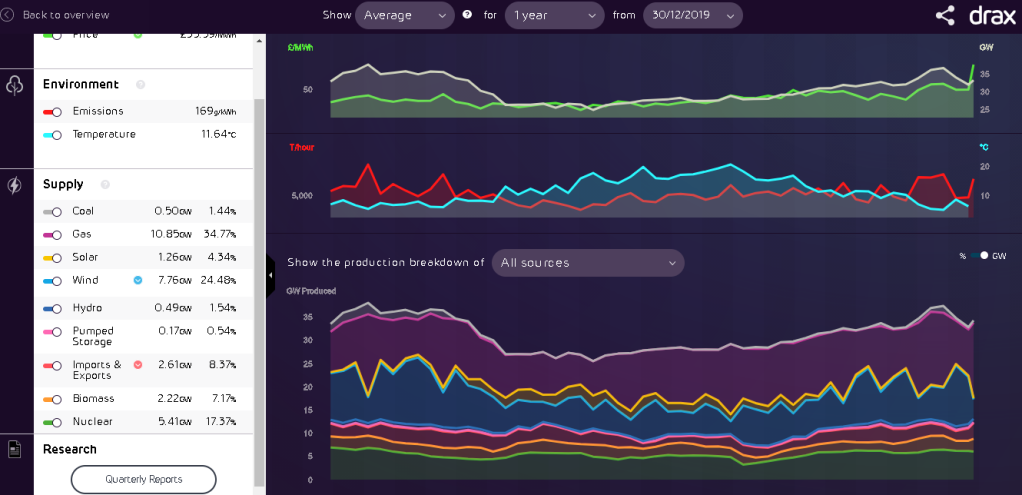Short version: Human consumption of energy and demand for products is driving climate change. Everything makes a difference, from the green house emissions due to our energy uses to our personal choices leading to deforestation on the other side of the world. We are reaching a tipping point where another small increase of temperature could lead to a snowball effect that puts climate change beyond our control. If all our choices are causing climate change then we can make changes to stop it. We can make choices now, in our everyday lives to slow down climate change.
For some reason my other half saw fit to put on Climate Change – the facts by Sir David Attenborough on TV on Christmas Eve. Er… yeah… little bit hypocritical of us given the gluttony and consumerism in the holidays.
If you haven’t seen it (it is very much worth watching), these are a few points:
Greenhouse gases, mostly carbon dioxide and methane are causing the temperature of the earth to rise with dire consequences:
- Death of species unable to adapt quickly enough.
- Melting of glacial ice is leading to rising sea levels and unpredictable stormy weather is leading to flooding. Homes are destroyed and people are being relocated. The melting ice also releases trapped pockets of methane (a worse greenhouse gas than carbon dioxide) that exacerbates the problem.
- Wildfires are raging out of control killing wildlife and destroying habitats and homes. The burning of the wood releases more carbon dioxide.
Deforestation is still continuing at a massive rate which is a problem for many species but inevitably for all, as the world’s forests, by photosynthesis, can suck up and store much of our carbon dioxide. With their ever diminishing size they are less and less able to mitigate human behaviour. Now a third of our CO2 emission is caused by deforestation. Rainforest is cleared and burned for soybeans, rubber, pasture for cattle and mostly palm oil. Demand in other countries is driving deforestation.
There have been some big changes like the switching from fossil fuels to renewable resources. Countries, depending on their situation are increasingly turning over the majority of their energy production to wind farms, solar cells or hydro electricity. There are other sources but these are the most prevalent.
Now this is the bit that is relevant to you (and me)… well all of it is relevant but it feels overwhelmingly difficult to comprehend and/or face the problem that we, as humans, have created for ourselves. Every person has a yearly carbon footprint. Everything we buy has some sort of carbon footprint. We can reduce this by simple things like insulating the house (which also reduces bills), buying less products (or by buying products of better quality that last longer). Because a quarter of the carbon footprint in the UK is food, that can be cut in half by:
- eating everything you buy i.e. avoiding waste
- avoiding air freighted food
- reducing dairy and meat – especially beef and lamb
The take home message was that we can all change our own behaviour and convince others too. Right now, we can still halt climate change – but there is only a small window before we reach a tipping point.
So… all a bit bleak – but let’s try and make this easier to see. Firstly, CO2 is a colourless gas! A tonne of carbon dioxide is a bit abstract. You can think of it as a cube with sides of 27 feet – around 8.23m – so 557.44m3. (click here for the source)
Then what does that look like in terms of use? Well, driving 10,000km in a petrol car creates around 2.5 tonnes (a diesel car is higher).
Then how much do we as individuals create?
Just to give you a few figures for (click here for the source):
| CO2 emissions in tonnes – average per person | |
| Global 2018 | 4.8 |
| UK 2019 | 5.3 |
| EU 2019 | 7.0 |
| US 2019 | 16.6 |
| China | 7.2 |
| India | 2.0 |
As I understand it, these figures include energy consumption, transport, products and services. There will be some things that are improving as countries turn their energy sources over to more renewable sources. Here we can look at the Drax website and you can see what percentage of the UK’s energy is derived from which source. If you compare 10 years ago to last year, in rough figures – coal went down from 30% to 2%, gas also came down from 47% to 35%, wind went up from 3% to almost 25%, nuclear didn’t move much from around 17% and hydro, solar and biomass combined have gone from almost zero to 13%.

2010 
2020
So much of what we buy have carbon footprints we don’t see. Take, for example, the box of chocolates that I’m feeling rather guilty about nibbling on:
Packaging – cardboard, foil, plastic – a tree was felled, metal ore was mined and extracted, crude oil was drilled and extracted as a raw material to make plastic… all of these things need a certain amount of transport and manufacturing and of course there’s also the dyes involved in the colours of the branding.
Ingredients worth noting:
- Sugar – can be grown in the UK, but requires much processing.
- Coconut oil – which isn’t grown here
- Palm kernel oil – really REALLY bad as it is one of the main crops that drives deforestation.
- Cocoa – which is definitely not grown here must be processed and shipped.
- Milk products – the dairy industry is a pretty hard on the environment. Rearing cows is energy consuming and cows produce a lot of methane.
All the ingredients must be transported to the factory and the chocolates produced and package. Then there is transport of the chocolates to the shop (then my kitchen table). Wherever energy is used in manufacture or transport chances are it will have caused the release of greenhouse gases. Demand for the ingredients like palm oil supports deforestation. I’ve never really noticed any of that carbon footprint till today. You may be pleased to know that I no longer feel like eating them.
So, my message, in the first blog of 2021 is that it’s not too late to do something about climate change, but time is short. It does require governments and industry to make the big changes, but in turn, these changes can be driven by voters and consumer behaviour. You can do little things to make a difference. Any changes that we make, no matter how small, can make a difference – especially if everyone gets involved. You could start small to keep it achievable or just by considering more environmentally friendly options through the year you could make a difference. I’m sure you all have plenty of ideas. All are welcome in comments. I’ll be implementing some of the things I’ve mentioned in this post into New Year’s resolutions, especially considering the products I’ll be buying, but as always, I’m very edible garden orientated and I believe it’s not just about what you do yourself – but also about getting the message out there and encouraging others:
Grow food. I encourage anyone, everyone to grow some food, even if it’s just on a windowsill or a balcony. The growing plant will take in carbon dioxide. Any food you can get from what you grow will have a tiny carbon footprint in comparison to something grown using intensive farming methods or something that required transportation. I think you can also be pretty sure that the things you grow to eat didn’t encourage deforestation on some other patch of earth. Eating plants over meat is much more environmentally friendly. This is one of the things we, as a family need to look at most. We do eat far too much meat, but, if we can grow more tasty veg (and home grow is definitely tastier), especially in the winter months and maybe in the lawn (I’m thinking of replacing our diminishing patch of grass with a bed or maybe just sowing some things in the grass itself), then maybe we’ll find it easier to eat less meat.
Composting of kitchen greens and waste cardboard reduces transport of waste and reduces the need for fertilisers or shop bought compost, both of which have manufacturing, as well as transport, carbon footprints. Click on each of the following for more info: composting, fertilisers, reusing and recycling at home, reusing and recycling in the garden.
Grow more perennials and self seeders. I’m going to grow more of these this year as perennials store carbon and buying seeds annually does require them to be produced and shipped. Seed sharing with others would be another option.
So much great advice in this post!
LikeLiked by 1 person
Thanks. Hopefully we can make enough changes before it’s too late.
LikeLike
Love this post. Ive been moving into being more sustainable little by little.
LikeLiked by 1 person
That’s wonderful. I think the message is filtering through to everyone. As long as we all know we need to make changes I think there’s hope. Happy new year btw.
LikeLike